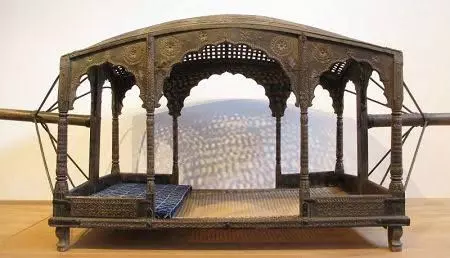Star Attractions: Digital Yakshi, 1911 Delhi Durbar chair at New Delhi expo
The three-day exhibition is special as there are 75 "star objects" drawn from 25 museums across India
By Newsmeter Network
New Delhi: An ornate palanquin from the mid-19th century, a royal chair used at the 1911 Delhi Durbar, digital version of the famed Didarganj Yakshi of Patna are among the "star objects" exhibited at the ongoing International Museum Expo in New Delhi.
The three-day exhibition is special as there are 75 "star objects" drawn from 25 museums across India
Royal Chair
A royal chair from the 1911 Delhi Durbar -- a grand ceremonial event held to announce the coronation of King George V and Queen Mary -- is attracting attention.
The exquisite 112-year-old chair belongs to The City Palace Museum, Udaipur.
King George V, the only monarch to attend his Coronation Durbar in India and Queen Mary were proclaimed emperor and empress of India during this ceremony.
"The chair was made for the then ruler of Mewar (Udaipur) Maharana Fateh Singh for the 1911 Delhi Durbar. However, he did not attend the Durbar from what we know, based on old records. So, at the exhibition, an old black and white photo of a scene from the Durbar, has been displayed in which one can see that the chair meant for the Maharana is empty while several other attendees can be seen in the amphitheater," said a senior official of the Maharana of Mewar Charitable Foundation (MMCF), Udaipur.
The backrest of the chair bears the insignia of the house of Mewar with the royal cypher of King George V -- GRI (Georgius Rex Imperator in Latin). The cypher, in turn, is flanked by 'DELHI' on one side and '1911' on the other, along with an ornamental scroll. Two small crowns top the chair on both sides.
"This traditional-style wooden chair is a magnificent handwork of vintage furniture. Its serpentine arms terminate in lion heads over the square red velvet upholstered seat, supported by double scroll legs terminating in scrolling ball feet," officials explained.
Ram Rewari
The 19th-century Ram Rewari, a ceremonial carrier for a deity used in a religious procession also belongs to City Palace Museum, Udaipur.
"It is made of silver with some wood and is used to carry the deity during the procession," he said.
An image from 1920-30 showing Maharana Fateh Singh with the Ram Rewari in the 'Shree Vishnu' processions has also been displayed next to the royal exhibit.
A Palanquin
A large palanquin -- with ornamental design on the wooden cabin and antique chamber -- made around 1850 and a marriage litter ('rahi') from the 19th-20th century from the Santhal region of Jharkhand are also on display.
Didarganj Yakshi in a digital avatar
Yakshi or the Chauri-bearer, was found on the muddy banks of the Ganga at Didarganj on the outskirts of Patna in 1917. This same year, the Patna Museum was founded.
It remained one of the star attractions of the museum until the sculpture was moved, along with a large number of antique items, to Bihar Museum.
The statue is 5 feet 2 inches tall and placed on a pedestal made with Chunar sandstone and finished to an incredible mirror-like polish. The Yakshi embodies close-to-perfect standards of feminine beauty of ancient India, according to the Bihar Museum website.
Some scholars place the statue in the Mauryan era while others date it to the late Kushana period.
At the exposition, the Yakshi has been represented in a rotating holographic image form.
"She (Yakshi) cannot be taken out of the museum, so we have shared a (digital) replica for this Expo," the Bihar government's Art, Culture and Youth Department Secretary Bandana Preyashi said.
Other Star Objects
Replicas of the Mother Goddess or Gajalakshmi and worship of the Bodhi tree (representing Kanakamuni), both dating to about the second century BC, have also been exhibited.
A stone Nataraja statue from the 11th century, a 19th-20th century painted temple door from Odisha, the mask of a tiger from the same period from the Andhra Pradesh region and a 20th-century Bidri box are among the rare exhibits on display.
A 6-feet tall Char Bhuja Dhari Vighnaharta made in 2017 entirely from automobile scraps from Ford cars and executed by the Ford Motor Company from the collection of the Heritage Transport Museum, Gurgaon, has also been displayed.
Exhibits from Salarjung Museum in Hyderabad, the Indian Museum in Kolkata, and many others have been put on display. The scale of participation is huge and about 1,200 museums and cultural institutions are taking part in this exhibition.
Inputs from PTI